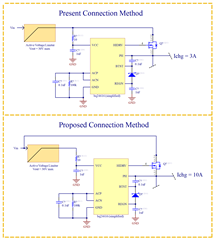I am presently using, with success, the bq24616 to charge a 6S lithium battery at a maximum charge current of 3A. The voltage input into the system is typically 28V. To prevent any voltage spikes on the bus from damaging the bq24616 IC, I have placed an active voltage limiter circuit in front of the bq24616 charging circuitry. A simplified example of this is shown in the image below. The active voltage limiter design uses a P-Channel MOSFET, so the on-resistance is on the order of 20mR. At 3A charge current, the power dissipation in this pass MOSFET is acceptable as long as it is not actively limiting the voltage. At a system-level, the controlling MCU stops charging if the input voltage rises above 30V. The limiting circuitry is meant to allow the bq24616 to survive, but not charge, during input overvoltage events.
A new feature request of this design is to increase the charge current to be in the 8A - 10A range. I am concerned about the power dissipation in the series voltage limiting circuit (the P-channel pass MOSFET) with the higher charging current, even with the voltage limit circuit not being active, the 20mR Rds of the fully-on P-channel MOSFET will still be present so I will now be rejecting single-digit watts of heat. See the "proposed connection method" shown in the bottom half of the image below. In this proposed schematic, the active voltage limiter circuit only has to supply the operation current of the bq24616 itself, with the primary battery charge current being drawn directly from the input voltage bus (what I refer to as DC-LINK in the title, referencing terminology used in SVPWM aka BLDC motor controllers). I do not expect Vin to exceed 30V for anything more than a moment, but with this topology, it seems that I could continue to charge at 10A well into the 30s and 40s of volts, should that ever occur (again, it won't).
This is a design update and I am looking to minimize copper changes, to reduce project risk as much as possible. I also understand that changing the power feed of the bq24616 may introduce its own risk. My question to the TI experts is whether they see any specific caveats or drawbacks to this proposed design.
Thanks in advance for any insights or suggestions,
Will


